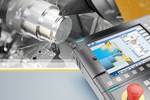Siemens CNC Portfolio Demonstrates Mold Machining Digitization
IMTS 2024: Bringing together a number of its hardware automation, digitalization software and services, Siemens present a path toward machine tool digitalization that is already helping mold and die shops invest in their future.
Siemens Industry Inc. highlights how its machine tool CNC portfolio and digitalization software technology, highlighted by the digital native Sinumerik One control platform for machining applications, is being used by mold and die shops to invest in the future of their employees and grow business.
“Three years ago, most of our surfacing work was done at a feed rate of around 50 to 60 in/min,” says one moldmaker. “With the Siemens CNC, some of our feed rates have already approached 200 in/min and what comes out of the machine is a part cut in much less time, and that offers repeated high quality to the customer.”
For instance, a CNC vertical machining center typically features integrated cooling during high-speed drilling. The coolant flows through the drill bit to flush the metal chips out and away from the flutes. Carbide drill bits last much longer and drilling cycles have been reduced from 5 minutes to 30 seconds. With Siemens’ technology, it is also now possible to drill a hole in one pass, rather than repeating up-and-down passes to clear metal chips from the hole and bit. This feature alone gives a mold shop the flexibility to increase the company’s margins or to strategically price jobs to win new business, according to Siemens.
Siemens’ Sinumerik One CNC control platform works with software to create the machine controller and the associated digital twin from a single engineering system, contributing to the total integration of hardware and software. Its interaction between the virtual and real worlds, including high-performance PLC, drive and motor hardware, seeks to improve productivity, performance and digitalization. Sinumerik One is provided with Create MyVirtual Machine and Run MyVirtual Machine software to create the universal concept of the digital twin, powerful hardware and integrated IT security, making it a forward-looking CNC. Moreover, using Mcenter, end-users can seamlessly link all their machine tools and network with a company’s IT landscape.
Siemens CNCs also give the ability to program the machine to minimize the time it takes to cut a part. A feature called “Advance Surface” enables a shop to optimize mold cutting velocity, accuracy and surface quality for the most efficient machining motion. Beyond “conversational,” the Siemens CNC is also an investment in a shop’s knowledge base and skills.
Other proven returns on the machine/control investment have been the faster production of consistent quality molds; leveraging newfound flexibility to produce different parts for different types of customers on the same machine; the ability to name and call up any of the tools in the toolholder; eliminating hours of “homing” restart time in the mornings due to a Siemens absolute encoder that holds the exact previous setting; and being able to download earlier Haas and FANUC files into the Siemens control with no losses and greater machining flexibility to gain.
Related Content
-
Moldmakers Deserve a Total Production Solution
Stability, spindle speed and software are essential consideration for your moldmaking machine tool.
-
Hands-on Workshop Teaches Mold Maintenance Process
Intensive workshop teaches the process of mold maintenance to help put an end to the firefighting culture of many toolrooms.
-
Fundamentals of Designing the Optimal Cooling System
The right mold components can help improve mold cooling and thereby produce higher-quality parts.
















